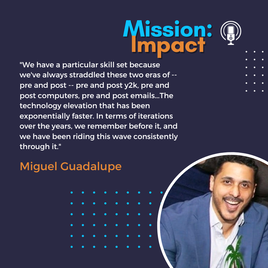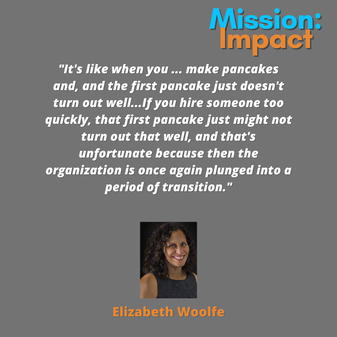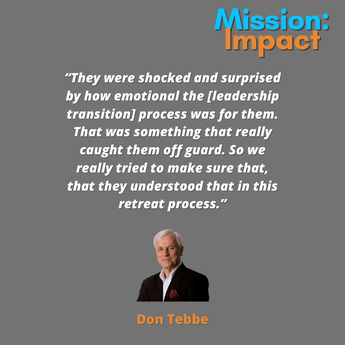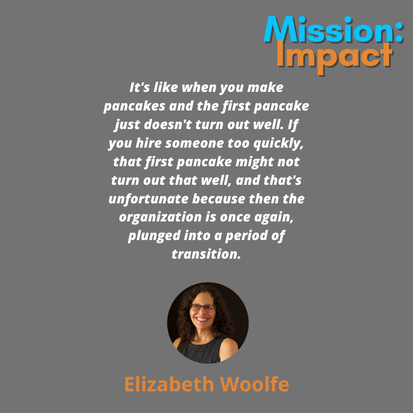Mission: Impact podcast & blog
Build a better world without becoming a martyr to your nonprofit cause
Listen on:
 In episode 89 of Mission: Impact, Carol Hamilton and Miguel Guadalupe discuss issues of generational engagement in nonprofit leadership, highlighting the frequent oversight of Generation X and stressing the unique adaptability and valuable perspective that this generation brings to the table. Miguel emphasizes the necessity for Generation X to advocate for recognition in leadership roles, reflecting on a LinkedIn post that sparked a broader conversation about the career stagnation felt by many in his generation. Episode highlights: Don’t Forget GenX: underrepresentation and unique contributions of Generation X in leadership and decision-making processes. Adapting to change: how Generation X's experience with the evolution of technology equips and other big changes over their career equips them with adaptability, a valuable skill set for leadership. Perpetual Utility player: Many of the Gen Xers who commented on Miguel’s LinkedIn post shared the feeling of being overlooked in their professional lives. Visibility and Advocacy: Miguel suggests that Generation X should take a lesson from Millenials and Gen Z and take a more assertive stance in advocating for their visibility and leadership opportunities. Guest Bio:
Miguel Guadalupe is Vice President of Donor and Community Relations at The Bowery Residents' Committee, or BRC in NYC. BRC helps over 10,000 individuals a year suffering from homelessness, mental illness, and addiction with the dignity and compassion they deserve. Miguel manages donor engagement, fundraising, and event planning, as well on service as BRC liaison to local elected officials, community organizations and businesses wherever a BRC program is located. He is also Vice Chair of the National Puerto Rican Day Parade, and helps to produce America's largest cultural celebration, in NYC, while helping to raise and distribute over $200K annually to students attending higher education. Important Links and Resources: Miguel’s viral LinkedIn post: https://www.linkedin.com/feed/update/urn:li:activity:7036817928465350656?updateEntityUrn=urn%3Ali%3Afs_feedUpdate%3A%28V2%2Curn%3Ali%3Aactivity%3A7036817928465350656%29 Miguel Guadalupe on LinkedIn: https://www.linkedin.com/in/miguelguadalupe/ The Bowery Residents' Committee https://www.brc.org/ Click "Read More" for Transcript  In episode 54 of Mission: Impact, Carol celebrates the podcast’s two year anniversary by doing a best of episode about nonprofit executive leadership transitions. We talk about:
Guests and Resources:
 In episode 32 of Mission: Impact, some of the topics that Carol and her guest, Don Tebbe discussed include:
Guest Information: Don Tebbe is an organizational planning consultant and one of America’s most experienced advisors on nonprofit CEO transition and leadership succession. He experienced, first-hand, the challenges of sustaining an organization and navigating leadership succession as a former nonprofit executive director and five-time interim CEO. Since 1993, he’s helped hundreds of nonprofit leaders plan for and manage turnover in their chief executive positions. Don was one of the national thought leaders involved in an Annie E. Casey Foundation-sponsored project to develop better practices for nonprofit leadership succession. Many of the concepts and practices used by succession practitioners today originated with the Casey project. He is the author of Chief Executive Transitions: How to Hire & Support a Nonprofit CEO and The Nonprofit CEO Succession Roadmap: Your Guide for the Journey to Life’s Next Chapter. Important Guest Links:
Click "Read More" for Transcript:  In episode 12 of Mission: Impact, some of the topics that Carol and her guest, Elizabeth Woolfe, discussed include: ● The importance of an interim director for nonprofit organizations ● The process of transitioning and the strain that puts on a nonprofit organization ● The importance of having a plan in place for when your leader leaves ● Growth mindset with Nonprofit Boards ● What the role of the Board and the role of the staff are in an organization and how those differ ● The importance of taking breaks for yourself Guest Information: Elizabeth Woolfe is a lifelong nonprofit professional with expertise in affecting strategic change and facilitating growth for organizations, as well as in assisting boards and organizations through transitions.She also has strength in building philanthropic relationships between nonprofit and for-profit companies, facilitating collaborations, and program development. Her particular areas of interest are interim leadership, management of organizations and boards, strategic assessment, organizational development, board functionality, and relationship building. Links: Click "Read More" for Transcript: Emerging from Crisis Photo by Pixabay Photo by Pixabay Challenge: A small watershed organization had survived a tumultuous several years after the death of its founder and long-standing executive director. During the founder’s tenure, the board had been a following, governance board. The board led by a new board chair had navigated many challenges including an unsuccessful merger attempt, theft by a caretaker at one of the organization’s properties and other problems. The board decided the organization needed to take stock and reimagine itself, making the most of the legacy left by the founder and rebuilding an organization to meet both today’s realities and live into a new vision its future. Approach: I interviewed the board members and supported board members as they interviewed external stakeholders. Through the interviews, it became clear that the organization while it wanted to engage in longer range strategic planning it was only in the position to do short range planning. Most board members had been involved with the organization for years and many were burned out. Yet some found it challenging to let go and allow new leadership to emerge. Many had come on during the founder’s tenure and were not prepared to engage in the hands on work that the organization now needed from its board and it now had no staff. I facilitated a one-day retreat to help the group uncover what they had learned from their experience and think about where the organization stood in terms of the phases of development that nonprofits typically go through and what it meant for what was required from the board at its present stage of development. Results: Over the course of the organization’s several years of turn around, the board chair had essentially been working part time for the organization without compensation. During the retreat, the board decided to make her executive director and pay her for her work. A new board chair was named. Several board members announced their departure making way for new leadership to engage with the organization. The board also set several short-term goals for the year. Building Shared Leadership Photo by rawpixel.com Photo by rawpixel.com Challenge: A well-respected state level education nonprofit decided to celebrate its 30-year anniversary by engaging in strategic planning to envision its future and set goals for the next 3-5 years. The organization had emerged from a challenging period in its history during which long-standing but no longer financially sustainable programs were sun-setted. The executive director who had been with the organization since its founding hoped to strengthen the organization’s staff and board leadership by increasing shared leadership. The board was small and the majority of it members are relatively new to the organization. The executive director priorities included considering whether the organization’s name adequately represents its work; how to build capacity within the staff and board for greater shared leadership with the executive director as well as longer-term succession planning. Approach: I interviewed all the board members, external stakeholders as well as the staff. I facilitated a session with board, staff and a few external stakeholders that encompassed a look back at the organization's accomplishments over its 30 year history, considered the trends in the wider environment impacting the organization and reviewed the themes that emerged from the interviews. The group then discussed what implications the trends and themes had for the organization as it considered its future direction. Results: Through the interviews a number of issues emerged including the weakness of the board. Through the feedback and discernment process in the first session, the board decided to take a break from strategic planning and focus on its own development. Six months later the board had recruited new members and taken steps to create more a sense of shared leadership with the executive director. Need similar results for your organization? Inquire about scheduling a coaching call. |
Categories
All
Archives
July 2024

Grace Social Sector Consulting, LLC, owns the copyright in and to all content in and transcripts of the Mission: Impact podcast, as well as the Mission: Impact blog with all rights reserved, including right of publicity.
|
Telephone301-857-9335
|
info[at]gracesocialsector.com
|
Grace Social Sector Consulting, LLC, owns the copyright in and to all content in, including transcripts and audio of the Mission: Impact podcast and all content on this website, with all rights reserved, including right of publicity.
|